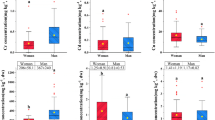Abstract
Lead and cadmium are toxic to humans at excessive levels, and monitoring the human body burden of these metals is important in preventing adverse health effects. In this study, we assessed the exposure to lead and cadmium among an elderly population 60 years of age or older. Based on data from 115 participants, we found that the geometric mean lead concentrations in hair and fingernails were 1.11 μg/g [95% confidence interval (CI) 0.78–1.58] and 1.11 μg/g (95% CI 0.81–1.51), respectively. The lead concentrations in hair and fingernails were significantly related to cigarette smoking. The geometric mean cadmium concentrations in hair and fingernails were 52.6 ng/g (95% CI 42.0–65.9) and 40.1 ng/g (95% CI 29.9–53.9), respectively. Cadmium concentrations in hair were significantly related to body mass index and cigarette smoking, whereas higher fingernail cadmium concentrations were related to alcohol drinking. Correlations between hair and fingernail concentrations of lead and of cadmium were slightly positive. Our findings suggest that the body burden of lead and cadmium varies according to demographic factors, and hair and fingernails could be used differentially as a biological medium for metal exposure.

Similar content being viewed by others
References
Hsu MJ, Selvaraj K, Agoramoorthy G (2006) Taiwan's industrial heavy metal pollution threatens terrestrial biota. Environ Pollut 143:327–334
Goyer RA (1996) Results of lead research: prenatal exposure and neurological consequences. Environ Health Perspect 104:1050–1054
Wong SL, Lye EJ (2008) Lead, mercury and cadmium levels in Canadians. Health Rep 19:31–36
Järup L (2003) Hazards of heavy metal contamination. Br Med Bull 68:167–182
Bellinger DC (2005) Teratogen update: lead and pregnancy. Birth Defects Res A Clin Mol Teratol 73:409–420
Bellinger DC, Bellinger AM (2006) Childhood lead poisoning: the tortuous path from science to policy. J Clin Invest 116:853–857
Dietert RR, Piepenbrink MS (2006) Lead and immune function. Crit Rev Toxicol 36:359–385
Gonick HC (2002) Lead, renal disease and hypertension. Am J Kidney Dis 40:202–204
Afridi HI, Kazi TG, Kazi NG, Jamali MK, Arain MB, Sirajuddin BJA, Kandhro GA, Wadhwa SK, Shah AQ (2010) Evaluation of cadmium, lead, nickel and zinc status in biological samples of smokers and nonsmokers hypertensive patients. J Hum Hypertens 24:34–43
Kazi TG, Jalbani N, Kazi N, Arain MB, Jamali MK, Afridi HI, Kandhro GA, Sarfraz RA, Shah AQ, Ansari R (2009) Estimation of toxic metals in scalp hair samples of chronic kidney patient. Biol Trace Elem Res 125:16–27
Afridi HI, Kazi TG, Kazi N, Jamali MK, Arain MB, Jalbani N, Baig JA, Sarfraz RA (2008) Evaluation of status of toxic metals in biological samples of diabetes mellitus patients. Diabetes Res Clin Pract 80:280–288
Plusquellec P, Muckle G, Dewailly E, Ayotte P, Jacobson SW, Jacobson JL (2007) The relation of low-level prenatal lead exposure to behavioral indicators of attention in Inuit infants in Arctic Quebec. Neurotoxicol Teratol 29:527–537
Satarug S, Moore MR (2004) Adverse health effects of chronic exposure to low-level cadmium in foodstuffs and cigarette smoke. Environ Health Perspect 112:1099–1103
Verougstraete V, Lison D, Hotz P (2003) Cadmium, lung and prostate cancer: a systematic review of recent epidemiological data. J Toxicol Environ Health B Crit Rev 6:227–255
Ades AE, Kazantzis G (1988) Lung cancer in a non-ferrous smelter: the role of cadmium. Br J Ind Med 45:435–442
Elinder CG, Kjellström T, Hogstedt C, Andersson K, Spång G (1985) Cancer mortality of cadmium workers. Br J Ind Med 42:651–655
Pesch B, Haerting J, Ranft U, Klimpel A, Oelschlägel B, Schill W (2000) Occupational risk factors for renal cell carcinoma: agent-specific results from a case–control study in Germany. MURC Study Group. Multicenter urothelial and renal cancer study. Int J Epidemiol 29:1014–1024
Kazi TG, Memon AR, Afridi HI, Jamali MK, Arain MB, Jalbani N, Sarfraz RA (2008) Determination of cadmium in whole blood and scalp hair samples of Pakistani male lung cancer patients by electrothermal atomic absorption spectrometer. Sci Total Environ 389:270–276
Arisawa K, Nakano A, Saito H, Liu XJ, Yokoo M, Soda M, Koba T, Takahashi T, Kinoshita K (2001) Mortality and cancer incidence among a population previously exposed to environmental cadmium. Int Arch Occup Environ Health 74:255–262
Nawrot T, Plusquin M, Hogervorst J, Roels HA, Celis H, Thijs L, Vangronsveld J, Van Hecke E, Staessen JA (2006) Environmental exposure to cadmium and risk of cancer: a prospective population-based study. Lancet Oncol 7:119–126
Nishijo M, Morikawa Y, Nakagawa H, Tawara K, Miura K, Kido T, Ikawa A, Kobayashi E, Nogawa K (2006) Causes of death and renal tubular dysfunction in residents exposed to cadmium in the environment. Occup Environ Med 63:545–550
Barbosa FJ, Tanus-Santos JE, Gerlach RF, Parsons PJ (2005) A critical review of biomarkers used for monitoring human exposure to lead: advantages, limitations, and future needs. Environ Health Perspect 113:1669–1674
Slotnick MJ, Meliker JR, AvRuskin GA, Ghosh D, Nriagu JO (2007) Toenails as a biomarker of inorganic arsenic intake from drinking water and foods. J Toxicol Environ Health A 70:148–158
Batista BL, Rodrigues JL, Nunes JA, Tormen L, Curtius AJ, Barbosa F Jr (2008) Simultaneous determination of Cd, Cu, Mn, Ni, Pb and Zn in nail samples by inductively coupled plasma mass spectrometry (ICP-MS) after tetramethylammonium hydroxide solubilization at room temperature: comparison with ETAAS. Talanta 76:575–579
Sreenivasa RK, Balaji T, Prasada Rao T, Babu Y, Naidu GRK (2002) Determination of iron, cobalt, nickel, manganese, zinc, copper, cadmium and lead in human hair by inductively coupled plasma-atomic emission spectrometry. Spectrochim Acta Part B 57:1333–1338
Paulsen F, Mai S, Zellmer U, Alsen-Hinrichs C (1996) Blood and hair arsenic, lead and cadmium analysis of adults and correlation analysis with special reference to eating habits and other behavioural influences. Gesundheitswesen 58:459–464
Rodrigues JL, Batista BL, Nunes JA, Passos CJ, Barbosa F Jr (2008) Evaluation of the use of human hair for biomonitoring the deficiency of essential and exposure to toxic elements. Sci Total Environ 405:370–376
Wilhelm M, Lombeck I, Ohnesorge FK (1994) Cadmium, copper, lead and zinc concentrations in hair and toenails of young children and family members: a follow-up study. Sci Total Environ 141:275–280
Wilhelm M, Ohnesorge FK, Hötzel D (1990) Cadmium, copper, lead, and zinc concentrations in human scalp and pubic hair. Sci Total Environ 92:199–206
Campagna D, Huel G, Hellier G, Girard F, Sahuquillo J, Fagot-Campagna A, Godin J, Blot P (2000) Negative relationships between erythrocyte Ca-pump activity and lead levels in mothers and newborns. Life Sci 68:203–215
Wolfsperger M, Hauser G, Gössler W, Schlagenhaufen C (1994) Heavy metals in human hair samples from Austria and Italy: influence of sex and smoking habits. Sci Total Environ 156:235–242
Anwar M (2005) Arsenic, cadmium and lead levels in hair and toenail samples in Pakistan. Environ Sci 12:71–86
Rodushkin I, Axelsson MD (2000) Application of double focusing sector field ICP-MS for multielemental characterization of human hair and nails. Part I. Analytical methodology. Sci Total Environ 250:83–100
Acknowledgments
This research was supported by the Basic Science Research Program through the National Research Foundation of Korea (NRF) funded by the Ministry of Education, Science and Technology (2009-0072222).
Author information
Authors and Affiliations
Corresponding author
Rights and permissions
About this article
Cite this article
Kim, M., Kim, K. Biomonitoring of Lead and Cadmium in the Hair and Fingernails of Elderly Korean Subjects. Biol Trace Elem Res 143, 794–802 (2011). https://doi.org/10.1007/s12011-010-8942-4
Received:
Accepted:
Published:
Issue Date:
DOI: https://doi.org/10.1007/s12011-010-8942-4




